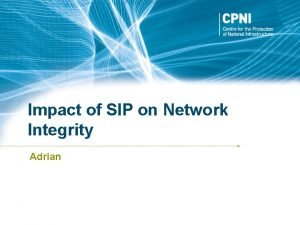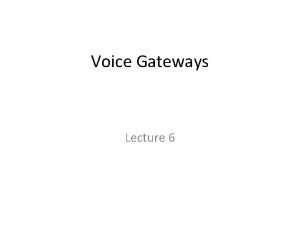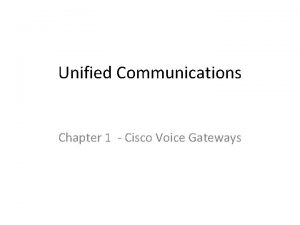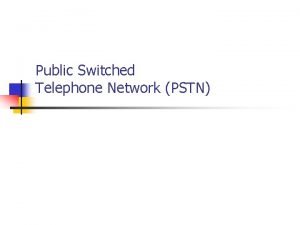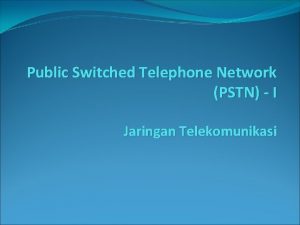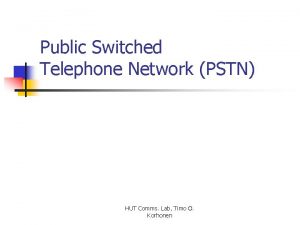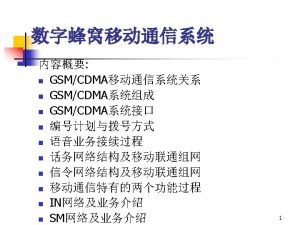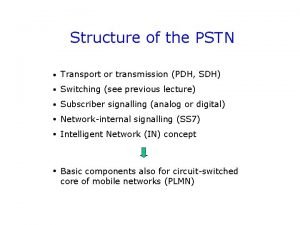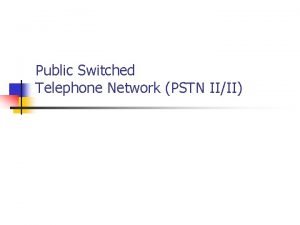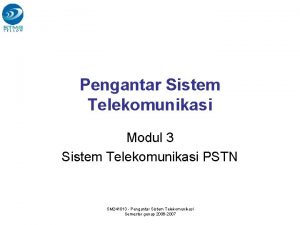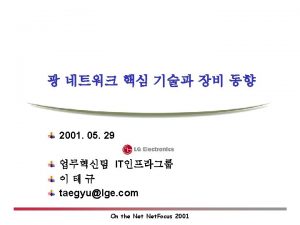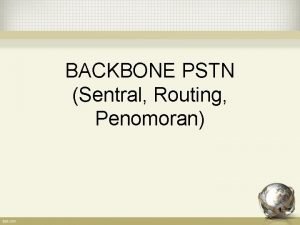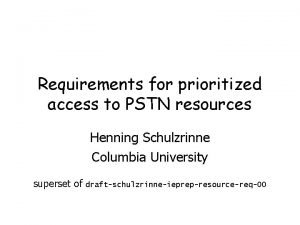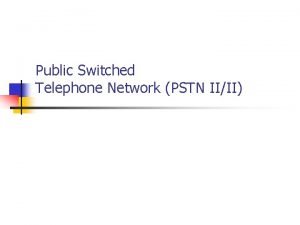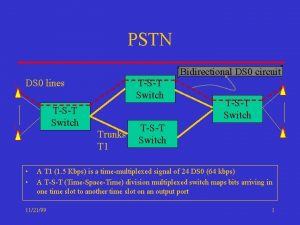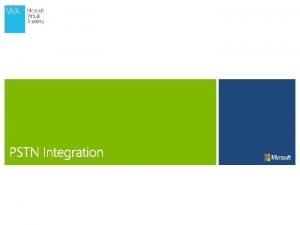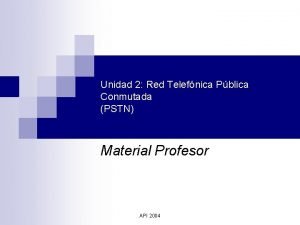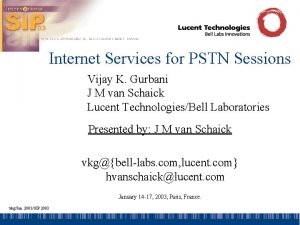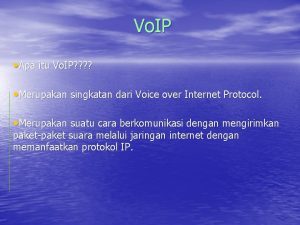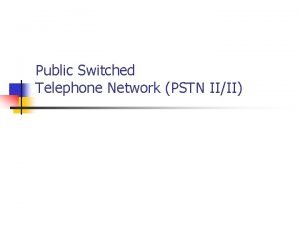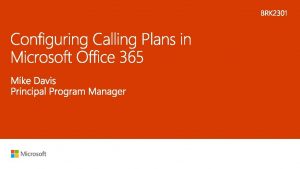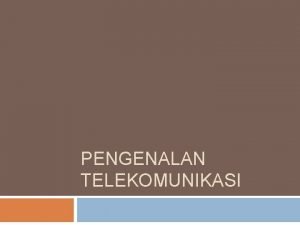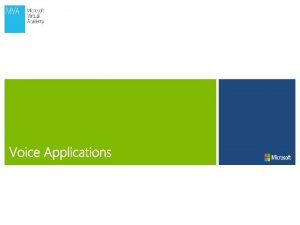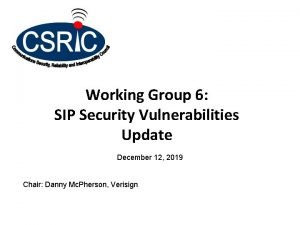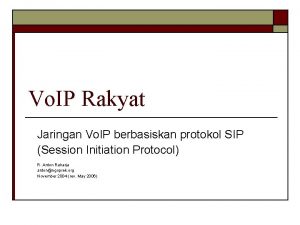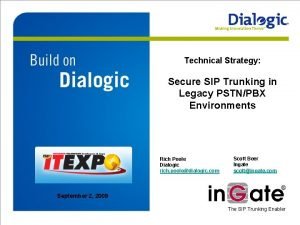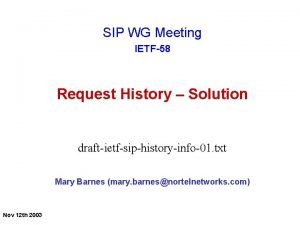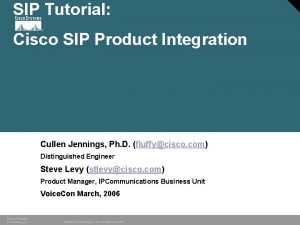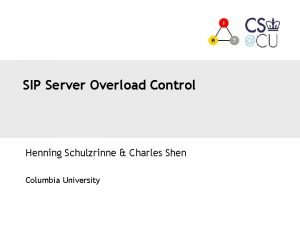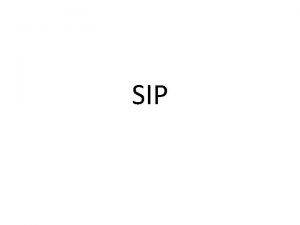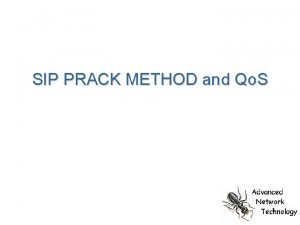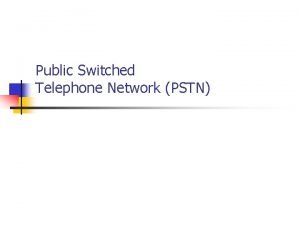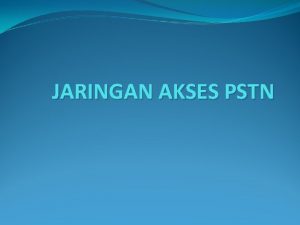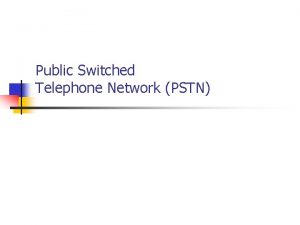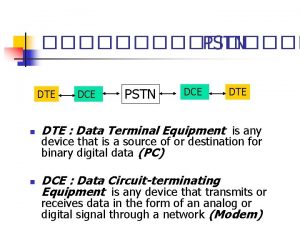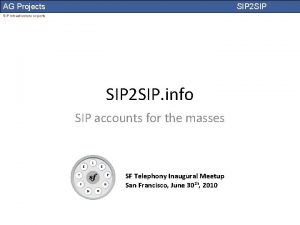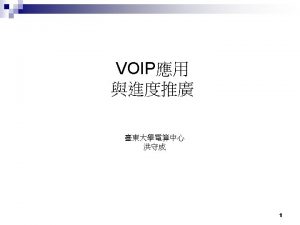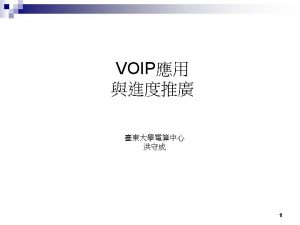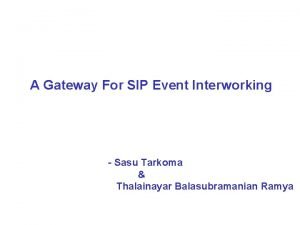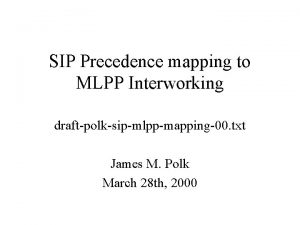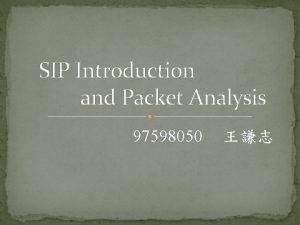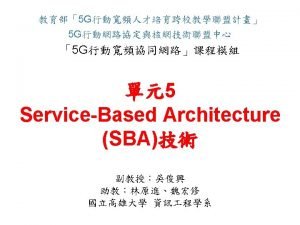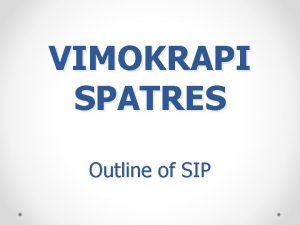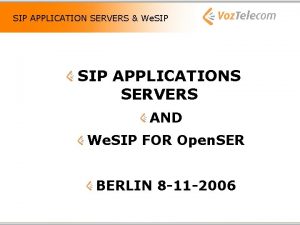Outline n SIP n PSTN and SIP interworking











































- Slides: 43


Outline n SIP ¨ ¨ ¨ n PSTN and SIP interworking ¨ ¨ n What’s SIP-T Architecture Translation of SIP-T Encapsulation of ISUP in SIP-T SIP-I ¨ ¨ ¨ n Interworking architecture Protocol overview SIP-T ¨ ¨ n SIP introduction SIP Architecture Components of SIP operation mode SIP message structure Specification of SIP-I TRQ. 2815 Q. 1912. 5 Summary 2

SIP Introduction n n Open, simple, extensible, and lightweight protocol Design for IP Networks Text-encoded protocol based on elements from the HTTP and SMTP. Same protocol used between services and call control entities Text-based encoding Easier to integrate with telephony and Internet functions Supports multiple call legs (i. e. , forking) In order to understanding SIP protocol, we need bearing in mind that ¨ Vo. IP = Signaling +Media 3

Protocol Stack SIP G. 711, G. 729 4

SIP Architecture 5

Components of SIP n User Agents: ¨ ¨ n User Agent Client (UAC) – Send Request (eg. invite…etc) User Agent Server (UAS) - Responds to clients’ requests (eg. successful. . etc) Server ¨ Proxy Server n n ¨ Registrar Server n n ¨ Receive SIP registration request update user agent’s information Redirect Server n n Receive SIP request from UA or other proxy Forward or proxies the request to another location Receive request from UA or proxy and returns a redirection response(3 xx) Location Server n n It contain user URL, IP address script, feature Routing information about Proxies, gateways and other Location server in SIP network 6

SIP basic operation modes Proxy Mode Proxy Server Peer to Peer Mode RTP 7

SIP Operation in User Registration 8

SIP Operation in Proxy Mode Router 9

SIP Operation in Redirect Mode 10

SIP message structure ¡Request = Request-Line * ( general-header | request-header | entity-header ) CRLF [message-body] Request-Line = Method SP Request-URI SP SIP-Version CRLF ¡Response = Status-Line * ( general-header | response-header | entity-header ) CRLF [ message-body ] Status-Line = SIP-version SP Status-Code SP Reason-Phrase CRLF 11

Request-Line of request message Request-Line = Method SP Request-URI SP SIP-Version CRLF Method : ¨ Register : Register to Registrar ¨ Invite : Invite someone to participate in a session ¨ Cancel : Cancel the invitation ¨ Bye : Finish the call ¨ ACK : Request confirm ¨ Options : Query a server to its capabilities Request-URI = SIP-URL without parameter or header element SIP-Version = ”SIP/2. 0” EX : 12

Status Line of Response message n Status-Line = SIP-version SP Status-Code SP Reason-Phrase CRLF SIP-Version = ”SIP/2. 0” Status-Code : ¨ provisional response n 1 xx – Informational ¨ final response n 2 xx - Successful n 3 xx - Redirection n 4 xx - Request Failure n 5 xx - Server Failure n 6 xx - Global Failures Reason-Phrase = “Trying”, “Ringing”… Ex : SIP/2. 0 100 Trying 13

Complete list of response codes 14

Request message Headers n general-header Apply to both request and response messages -Ex: Via, From, To, Call-ID, CSeq, Contact, User-Agent … n request-header The additional information about the request -Ex: Proxy-Authorization, Max. Forwards, … n entity-header Define meta-info about the message body -Ex: Content-Length, Content-Type The resource identified by the request -Ex: Allow, Expires *Refer to RFC 2543 Section 4. 1 15

SIP Header field 16

Message Body n n n n v=0 o=User. B 2890844527 IN IP 4 there. com s=Session SDP c=IN IP 4 110. 111. 112. 113 t=0 0 m=audio 3456 RTP/AVP 0 a=rtpmap: 0 PCMU/8000 17

SDP Specification Session description v= (protocol version) o= (owner/creator and session identifier). s= (session name) i=* (session information) u=* (URI of description) e=* (email address) p=* (phone number) c=* (connection information - not required if included in all media) b=* (bandwidth information) One or more time descriptions (see below) z=* (time zone adjustments) k=* (encryption key) a=* (zero or more session attribute lines) Zero or more media descriptions (see below) Time description t= (time the session is active) r=* (zero or more repeat times) Media description m= (media name and transport address) i=* (media title) c=* (connection information - optional if included at session-level) b=* (bandwidth information) k=* (encryption key) a=* (zero or more media attribute lines) *Refer to RFC 2327 Section 6 18

SIP extensions list 19

PSTN and SIP interworking

Architecture of IP network communication with PSTN 21

Voice IP Protocol overview 22

Interworking between PSTN and IP network ISUP call control signaling 23

SIP-T

What is SIP-T? n n SIP-T(SIP for Telephones) is define by IETF Not an extension to SIP – a set of practices for interfacing SIP to the PSTN, It provides two key characteristics ¨ Encapsulation of ISUP in SIP ¨ Translation of ISUP parameters n n to SIP headers Implemented at PSTN gateways, and carried end-to-end SIP-T Specification families : RFC 3372 : SIP for Telephones (SIP-T): Context and Architectures ¨ RFC 3398 : ISUP to SIP Mapping ¨ RFC 2976 : The Session Initiation Protocol (SIP) INFO Method ¨ RFC 3204 : MIME media types for ISUP and QSIG Objects ¨ 26

IP network interworking with PSTN using SIP-T architecture 27

Translation of SIP-T 28

SIP-T scenario 1 29

SIP-T scenario 2 30

Encapsulation of ISUP in SIP-T n n n Extending SIP-T by encoding SS 7 ISUP signaling messages allows MGCs using SIP-T to be compatible with the PSTN. SIP-T encodes and transmits the native signaling messages from one SCN to another. To do this, SIP-T has been extended with MIME encoding of signaling messages. The PSTN signaling messages are appended to the SIP-T messages (such as INVITE, ACK, BYE) using binary encoding. The use of MIME encoding with content type: APPLICATION allows PSTN signaling messages to be tunneled between MGCs. The use of content SUBTYPE enables SS 7 ISUP messages to be differentiated by the receiving MGC. 31

SIP-T scenario 3 32

PSTN-SIP v. s PSTN-SIP-PSTN INVITE sip: +1 -972 -555 -2222@proxy. carriew. com/user=phone SIP/2. 0 Via : SIP/2/0/UDP gw 1/carriwe. com: 5060 From : sip: +1 -314 -555 -2222@gw 1. carrier. woo, . com; user=phone To: sip: +1 -972 -555 -2222@proxy. carriew. com/user=phone Call-ID: 12345602@gw 1. carrier. com CSeq: 1 INVITE Contact : sip: +1 -314 -555 -2222@gw 1. carrier. woo, . com; user=phone Content-Type: application/sdp Content-length: 156 v=0 o= GATEway 1 2890844527 IN IP 4 gatewayone. carrier. com s=Session SDP c= IN IP 4 gatewayone carrier. com t= 0 0 m= audio 3456 RTP/AVP 0 a = rtpmap: 0 PCMU/8000 33

SIP-I

Specification of SIP-I n n SIP-I (SIPwith. Encapsulated. ISUP ) is defined by ITU-T (only draft until now) ITU-T Series Q Supplement 45: Technical Report TRQ. 2815(Requirements for Interworking BICC/ISUP Network with Originating/Destination Networks based on Session Initiation Protocol and Session Description Protocol) ¨ 定義了SIP與BICC/ISUP 互通時的技術需求,包括閘道 器類型、介接單元(Interworking Unit) 所應支援的協 定能力配置集與閘道器的安全模型等。 n ITU-T Recommendation Q. 1912. 5(Interworking between Session Initiation Protocol (SIP) and the Bearer Independent Call Control Protocol or ISDN User Part) ¨ Q. 1912. 5則定義 介接程序。 SIP與BICC/ISUP在介接單元的信號 35

TRQ. 2815 Defines the signaling interworking between the Bearer Independent Call Control (BICC) or ISDN User Part (ISUP) protocols and Session Initiation Protocol (SIP) with its associated Session Description Protocol (SDP) at an Interworking Unit (IWU) Profile A was defined to satisfy the demand represented by 3 GPP in TA 24. 229 V 5. 1. 0 Profile C supports the trunking of traffic via transit SIP networks using MIME encoded encapsulated. ISUP (SIP-I) Profile B complements Profile A, and both of them are intended to support traffic that terminates within the SIP network. 36

Scenario 37

Q. 1912. 5 n ISUP to SIP/SDP mapping Message mapping ¨ Parameter mapping n Scope of parameter n Mapping of ISUP parameters to SIP/SDP ¨ ¨ n Initial address message (IAM) mapping to SIP Encapsulation Scenario Encapsulation format 38

ISUP- SIP-I Message mapping ISUP Acro ISUP Message name SIP message GRA Circuit group reset acknowledgement GRS Circuit group reset BYE 500 Server Internal Error IAM Initial address INVITE IDR Identification request INFO 183 Session progress IRS Identification response INFO 183 Session progress INF Information INR Information request LPA Loop back acknowledgement LOP Loop prevention INFO 183 Session progress NRM Network resource management INFO 183 Session progress OLM Overload PAM Pass-along PRI Pre-release information INFO 183 Session progress REL Release BYE Message codes] RES Resume INFO 183 Session progress RLC Release complete BYE (note) BYE 500 Server Internal Error ACM Address complete 180 Ringing 183 Session progress (profile C only) ANM Answer 200 OK INVITE APM Application transport INFO or 183 Session progress BLA Blocking acknowledgement ISUP side only BLO Blocking ISUP side only CCR Continuity check request ISUP side only CFN Confusion INFO or 183 Session progress CGB Circuit group blocking BYE 500 Server Internal Error CGBA Circuit group blocking ACK ISUP side only CGU Circuit group unblocking ISUP side only CGUA Circuit group unblocking ACK ISUP side only CON Connect 200 OK INVITE COT Continuity UPDATE CPG Call progress 180 Ringing 183 Session progress (profile C only) CRG Charge information RSC Reset circuit CQM Circuit group query SAM Subsequent address CQR Circuit group query response SDM Subsequent directory number DRS Delayed release (reserved – used in 1988 version) SGM Segmentation Reassembled message ncapsulated. SUS Suspend INFO 183 Session progress FAA Facility accepted INFO 183 Session progress UBL Unblocking FAC Facility INFO 183 Session progress UBA Unblocking acknowledgement FAR Facility request INFO 183 Session progress UCIC Unequipped circuit identification code FOT Forward transfer INFO 183 Session progress UPA User part available FRJ Facility reject INFO 183 Session progress UPT User part test ISUP side only USR User-to-user information INFO 183 Session progress NOTE: The Release Complete message is a link specific message and may invoke BYE on some legs. 39

Summary

Protocol summary 41

SIP interworking capability “profiles” 42


Reference n n n n n Keith Mainwaring : IP Telephony Migration Challenges PCC. I-TEL/doc. 0202/03, “Next Generation Networks Standards Overview (September 2003)” ITUT Signalling Protocols for NGN RFC 3398 -ISUP to SIP Mapping RFC 3372 -SIP-T-Context and Architectures ITU-T Recommendation Q. 1912. 5, modified 王培元 : 新世代電信網路電信級分封電話信號系統之效能 模式及分析 中國IT 實驗室 : 软交换协议比较和发展趋势 Henry Sinnreich : Delivering Vo. IP and Multimedia Service with Session Initiation Protocol 44
 Sip outline
Sip outline Examples of quote sandwiches
Examples of quote sandwiches Types of voice gateways
Types of voice gateways Cisco pstn
Cisco pstn Public switched telephone network diagram
Public switched telephone network diagram Nama lain dari pstn adalah
Nama lain dari pstn adalah Pstn circuit
Pstn circuit Apa itu pstn
Apa itu pstn Pstn
Pstn Pstn cloud
Pstn cloud Karakteristik pstn
Karakteristik pstn Arti pstn
Arti pstn Cloud pbx outlook add in
Cloud pbx outlook add in Isup call flow
Isup call flow Public switched telephone network diagram
Public switched telephone network diagram Pengertian pstn
Pengertian pstn Diagram pstn
Diagram pstn Pstn speed
Pstn speed Struktur jaringan pstn
Struktur jaringan pstn Pstn images
Pstn images Pstn hierarchy
Pstn hierarchy Pstn tst switch
Pstn tst switch Pstn
Pstn Telefonía pública básica conmutada
Telefonía pública básica conmutada Pstn
Pstn Merupakan singkatan dari
Merupakan singkatan dari Pstn circuit
Pstn circuit Pstn conferencing
Pstn conferencing Definisi pstn
Definisi pstn Microsoft teams pstn nz
Microsoft teams pstn nz Jaringan publik adalah
Jaringan publik adalah Call park definition
Call park definition School improvement plan sample deped
School improvement plan sample deped Sip security vulnerabilities
Sip security vulnerabilities Berikut format alamat sip yang benar adalah
Berikut format alamat sip yang benar adalah Verizon sip trunk
Verizon sip trunk Sip trunking poole
Sip trunking poole History-info sip header
History-info sip header History-info sip header
History-info sip header Sip tutorial
Sip tutorial Slidesvo
Slidesvo Sip security issues
Sip security issues Sip protocol
Sip protocol Sip prack call flow
Sip prack call flow
